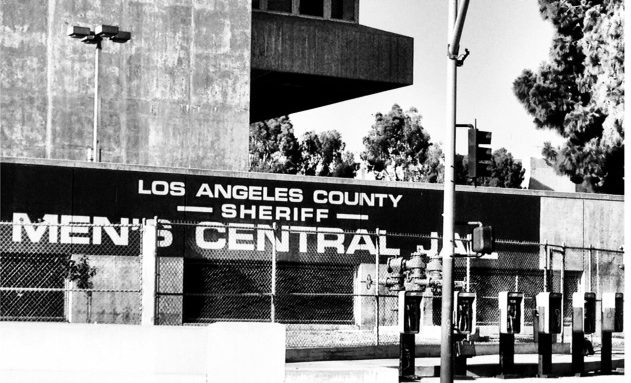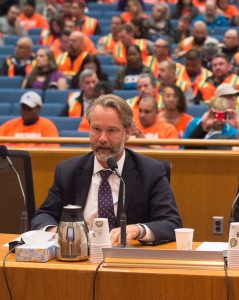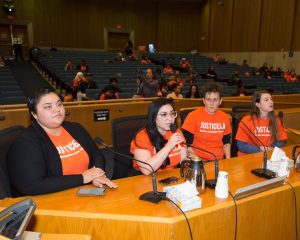On Tuesday, the Los Angeles County Board of Supervisors voted to fundamentally change their plan to replace the unhealthy and unsafe Men’s Central Jail facility with a shiny new high-tech mental health jail known as the Consolidated Correctional Treatment Facility (or CCTF).
Now, the nearly uninhabitable, 1963-built downtown LA jail facility will be replaced by—not another jail—but by a new “Mental Health Treatment Center,” as the new planned facility is now named.
And that new treatment center will not be operated by the Los Angeles Sheriff’s Department, which controls the county’s jail system.
Instead, the county’s Department of Health Services will oversee the facility.
Furthermore, the treatment center will be staffed by members of the Department of Mental Health, instead of sheriff’s deputies.
“Sheriff’s deputies will never receive enough training to become mental health professionals, nor should they,” said Supervisor Janice Hahn who, together with Supervisor Mark Ridley-Thomas, sponsored the motion that proposed the new strategy.
“And jailers armed with tasers and pepper spray are inherently detrimental to creating the safe environment necessary for healthcare. ”
(There would still, however, be some deputies who provide security for the new treatment center. )
The motion, which narrowly passed with a 3/2 vote, will still ensure that MCJ would be torn down, and its inmates will still be transferred next door to the Twin Towers Correctional Facility, which now houses the county’s jailed mentally ill.
“Men’s Central Jail is a decrepit, outdated facility inconsistent with human values and basic decency,” said Hahn. “It puts both our inmates and our sheriff’s deputies at risk.”
“We rejected a jail for those with mental illness,” said Ridley-Thomas, “and instead committed to looking into providing mental health treatment through a decentralized continuum of care.”
The board, he said, also “invested in a plan to scale up diversion,” and commissioned multiple studies “to better understand and serve those in our care.”
When Hahn introduced the newly reformed-minded motion at Tuesday’s meeting, she made it clear that the county will still award the design/build contract to McCarthy Building Companies, Inc, which was to design and construct the originally proposed jail treatment facility, CCTF.
But, instead of building the state-of-the-art jail, she said, the county will instruct McCarthy to develop and build a new design for the Mental Health Treatment Center “that is informed by leading research.”
Some opposition
Not everyone was thrilled with the idea.
Supervisors Sheila Kuehl and Hilda Solis both voted against the revised project, saying, basically, that the change didn’t go anywhere near far enough. The two had co-authored a competing motion that strongly suggested putting the jail building project on pause, in order to “reimagine” the whole tear down and rebuild project with an emphasis on diversion and treatment.
At one frustrated point, Kuehl mused aloud about what it felt like “to have to think through some of the some of the largest issues of your time.”
She considered it a great privilege, she said. “But there’s a lot of lost sleep, honestly, among the five of us.”
Solis pointed out that, with the original plan to build a new jail on MCJ’s footprint, “every phase of the project” must be fully signed off “by the Board of State and Community Corrections,” known as the BSCC. Would that still be true with the retooled non-jail project, Solis wanted to know?
After some discussion with other county officials, it was suggested that maybe the new, non-jail plan would no longer need BSCC approval. But, Solis’ question had made its point.
“It’s still a jail,” she said. “It’s still preventing people from having freedom. Now we’re proposing the largest mental health institution. For many of us, that is not going to do.”
Out of the reportedly 150 or so advocates and experts who signed up to speak on the issue of jails and mental health, few wanted to go ahead with the 3,855-bed project to be built on the footprint of MCJ, no matter what it would now be called, and who would run it.
Instead most pushed passionately for more diversion and community-based health centers.
“I believe this amendment was well-intentioned,” said the ACLU’s Peter Eliasberg, when it was his turn to speak about the revised plan. But he wanted to point out, he said, that the largest state mental hospital in California has 1200 beds.
“That’s Atascadero,” he continued grimly, referring to California’s notoriously troubled facility built to treat mentally ill criminal offenders.
“It’s not a place of healing. It’s not a place of diversion. it’s not a place of recovery. And you’re talking about building something three times the size of Atascadero.” Eliasberg paused. “You cannot provide good mental health care in a facility designed for 4000.”
Eliasberg’s comments, plus a few others, inspired one more amendment to the motion before its passage, this one a read in by Ridley-Thomas.
This amendment instructs various county’s departments, together with the CEO, and “community stakeholders,” to report back with options to “right-size the scale and scope of the project,” to “ensure a decentralized, trauma-informed approach to achieve the goals of improved treatment and public safety, in conjunction with diversion to community-based mental health treatment, whenever possible.”
The new amendment to the amendment, said Ridley-Thomas, is designed to say, ‘Look, exhaust the range of these opportunities of opportunities and possibilities so that what we ultimately wish to see happens in terms of better patient outcomes.”
“We still have a lot of work to do,” he added.
It wasn’t yet clear how flexible the structural variations of the proposed new non-jail could be from the previous jail building plan—at least within the existing, just-approved contract.
But, as Kuehl noted, before any actual large sums of money can be moved, another approval by the board would be required, this one necessitating four yes votes to pass, not the usual three. In other words, there was still time for further consideration, and further pivoting.
It wasn’t clear what those at the sheriff’s department felt about their removal from the pricy project, as no one from the department appeared to have been invited to speak on the matter.
Considering women’s needs
An important and far less contentious moment occurred at Tuesday’s meeting when the board voted on a motion Kuehl read into the agenda, which would nix the planned Mira Loma Women’s Center project—a.k.a. the new women’s jail that was to have replaced the existing women’s jail, Century Regional Detention Center or CRDF, in Lynwood.
As Kuehl pointed out, the Mira Loma location posed “insurmountable obstacles’ to the goal of “creating a women’s jail that is the centerpiece of a gender-responsive corrections system.”
Located in the Antelope Valley, Mira Loma would have meant visiting families from most other areas of the county would have had to travel three hours or more one-way if they took public transportation to visit their loved ones.
(WLA wrote earlier about the problems with the Mira Loma project.)
In a related action, the board also passed a second motion that would require the hiring of “expert consultants on gender responsive programming’ for the existing women’s jail, Century Regional Detention Facility (CRDF). The idea is for the consultants to help design, develop and program a new women’s jail to replace the now-canceled Mira Loma facility.
The motion would also trigger additional research to “collect and analyze data on the pathways that result in the arrest, prosecution, and incarceration of women in LA County.”
In explaining why she thought this motion important, Kuehl pointed to the work of the UCLA research group called Million Dollar Hoods. “They indicate,” she said, that the five most common reasons women are jailed are for theft, drug possession, driving on a suspended listen, driving under the influence, and failure to appear.
“Those are not the crimes of the century, usually,” she said. But they’re certainly enough to disrupt and devastate a family. So it’s essential that the county develop a forward-thinking, gender-responsive plan for justice-involved women in particular.”
Solis, who co-authored the motion with Kuehl, also described the combination of the two motions as representing a perspective that was long overdue, that she hoped would “identify needed holistic programming and services based on best practices for incarcerated women and their families, as well as practical solutions to keep women out of the criminal justice system and out of jail.”
Ridley-Thomas added his own summation later in the day.
“The work is complex,” he said. “The nine motions today on these topics underscore this.” But, he was encouraged by the progress the county had already made, “diverting nearly 3,000 individuals from jails to treatment,” among other things.
“It is time to expand upon these solutions, and today was an important step in that direction.”






Celeste,
Read my post from your previous article on this subject.
With the Governor’s decision and the BOS vote, it’s like I had a crystal ball, or I’m really Fucking smart.
Now it’s your job the pressure the legislature to redirect the train money to mental health in the big counties.
The BOS money needs to stay for a new CJ.
Curious that Sheriff Villanueva is not getting any credit for this, either at Witness LA or in the LA Times. In fact he campaigned on this, as well as not housing the females in the desert. He spoke to both at debates. As opposed to McDonnell, who pushed both jailing the mentally ill in LASD facilities and the women’s jail in the A/V. Yet McDonnell is not getting any blame for prompting these reversals. This is all cast as BoS saves the day, which is not how we got here. Or at least not the full story.
Has anyone looked into possible BOS links to McCarthy Building Compainies? You know, the usual corruption stuff, family members employed by, campaign contributions, family ties to subcontractors and the like. We are talking about 2 billion dollars here, maybe all this social justice gas is just a smokescreen. How about some of that “gumshoe reporting” we’ve heard so much about, I know it’s not as easy as just forwarding BOS press releases, but isn’t it usually a good idea to “follow the money”?
This article reminded me of what my instructor said about Psychology in the Psychology 1A class I had to take to meet a General Education requirement for my Baccalaureate many decades ago:
Psychology is an elevated form of voodoo.
If we think that 2.2 BILLION is a lot of money just wait until the bill comes in for this fiasco. So, how is it NOT racist, sexist and inhuman to put inmates from MCJ into the TT? I predict that at least two supes won’t be there after the next election. Regardless, we still need a new jail. Yup, it was Sheriff AV that campaigned on closing Mira Loma.
So, let me get this straight. It’s not a jail, but it is a place where the patients are not free to go and security is provided by Sheriff’s Deputies. It is being run by the Mental Health Department, so who tells the Sheriff’s Deputies what level of “security” is to be provided. Would they just sit at the front door and not allow the patients to come and go as they please with all internal “security” being be provided by MHD? And what happens when a patient gets a little feisty? If DMH hired staff, who will not be subjected to the kind of background and training that Deputy Sheriff’s have gone through, are going to be expected to safely deal with them – and somehow will be expected to do so without using force. Is this facility going to be part of the LA County Jail – by state constitution the responsibility of the Sheriff? If it is not part of the LA County Jail, how are these patients going to be there, when they have been remanded to the CARE of the Sheriff by a judge? So if it is too big as the ACLU suggests, what who is going to happen to the overflow of mental health prisoners. If the facility is downsized what happens about the loss of beds in the “system” as a whole.
Rube Goldberg would love this idea.
This is how a mental health facility is ran, check out the state hospitals that employ orderlies for internal day to day heavy lifting, and utilze law enforcement when the “patients” get “a little feisty” and more than they can handle. This is how any mental health facility is ran. The goal is to get mental health care out of the hands of law enforcement or correction’s right? It has been argued, shouted and yelled that jail guards abuse and mis-treat the mentally ill and have no clue what they’re doing.
Now that law enforcement is going to be out of the business of mis-treating sick mental patients, it sounds like a win-win for the public, ACLU, DOJ, politicians and Sheriff’s Department.
I’m sure the Sheriff’s Department is all broken up about not having to deal with mentally ill inmates in the future.
Conspiracy, ohhhhhhhkkkkkkkkkkkkaaaaaaaaaaayyyyy, so the Deputies are called in and have to “restrain” the patient. According to who’s rules in this non-jail run by DMH? Does the Sheriff’s Department just say “they work for them – not our problem” when the patient has a heart attack and dies? Who gets sued when things go south. Does the BOS just say, “that shit happens in mental hospitals.” – like they would if Sheriff Deputies were not involved? Can the Deputies skip the rheems of forms required after a force incident?
We know the answers to those questions. Think about trying to “manage” it from the Sheriff’s perspective. You don’t own any of it, but you own the worse part of it. Brilliant move.
The LASD has maintained a “jail” at LAGH for decades. The deputies there are running the exterior and are responsible for inmate discipline. Hospital staff is responsible for all medical issues. There has never been any major issues there. Granted, mental health patients are not as docile as the LAGH prisoners, but the same concept could work if though through. Agreed, allow “orderlies” working for DMH to deal with the prisoners day to day with Deputies present as back-up. Envision Twin Towers where there is a central control booth, where a Deputy could be stationed watching the activities of several modules. DMH staff, with their orderlies could be conducting business under the watchful eyes of Deputies, who would not give assistance unless requested. But Deputies would control all movement, visiting etc. It would still be a jail. It needs to be a jail for legal reasons. And for practical reasons.
The defense rests.
How would it be any different than Mira Loma?
Wouldn’t it just be a contract and deputy force would be reported and documented up the LASD side?
Everyone gets sued! That’s the beauty of it.
@Curious, the difference is Mira Loma is/was/will be operated by the LASD, owned by the LASD maintained by the LASD, etc. It just so happens there were some of contract prisoners there. (Only the names were changed to protect the innocent) The bottom line is that the LASD made ALL decisions regarding the facility.
Under this proposal the facility is owned, operated etc by DMH. Their rules, their policies, their management. Think of this: they would say how many, if any, Deputies are assigned to a given area (think officer safety), they would dictate if Deputies could search for contraband (think officer safety). At LAGH there are no such restrictions. LASD makes those decisions. It just isn’t practical to have LASD working under the guidance of DMH – at least I wouldn’t want to.
One understands the LASD desire to get out of the mental health business. Been there, done that. But the idea of putting LASD staff in such a facility being run by another entity is foolish, IMHO. LASD must be in charge of their own lock-ups. The reality is that DMH currently runs the mental health program at TT but no on wants to admit that. DNH decides on all matters relating on the care of mental health prisoners. It is not a secret – except to the LA Times and the BOS.
Granted, the facility is not ideal for the situation, but it is the most appropriate that LASD has. Perhaps the LASD end has faltered at times, but that can/is be(ing) minded. Yes a better facility would be beneficial and perhaps the working arrangement between the DMH and LASD can be altered to place more DMH staff on the floors, and less LASD, but the LASD must be responsible for operating the “jail” if it contains County Jail inmates.
I believe an issue that does not seem to be addressed by our “experts” is their belief that TTCF is a “treatment” center. Perhaps in some cases, but in reality it is more of a “triage” center when you consider the average stay in the jail system is something like 42 days. That means a very high percentage of these folks are only there for a week or two. You can’t really do much with a mental health patient in such a short period of time. Just shove pills down their throats for a few weeks and release them. Yeah, some get longer term treatment, but it is a real mixed bag.
BUT I think the building of a new facility creates an opportunity to fix some of the shortcomings in such a system. Why not designate a portion which would not be part of the “jail”. This portion would be a secure area not dissimilar to the jail portion of the building and perhaps overseen by the Probation Department. In this area individuals who have mental health issues and have been convicted/accused of crimes could be committed by local judges or through plea agreement. With this commitment these people could get REAL long-term treatment and not be a place where they were part of the high turn-over inventory that is the inherent environment of a county jail. The two facilities could share the same building(s), the same DMH staff and even share things like food/medical services. The “prisoner” ,once committed by a judge, would become a “patient” and simply be moved from one part of the building to another. His medical records and even his treating staff would be immediately available.
Such a plan would provide an opportunity for local officials to provide a secure place for mentally ill offenders to get badly needed help. As it is today, these people are only part of a revolving door with them being pushed from place to place, never having a chance to get real, meaningful help. It is no one’s fault, it is the fault of a “system” that does not care about them as individuals.
I don’t understand why it is assumed that LASD would be involved in any way other than providing exterior security to prevent patitients from leaving or to take reports in case the staff is assaulted? The goal is to get deputy Sheriff’s and custody assistants out of the orderly business since their not trained and I’ll equipped to perform these duties. This was also illuded to in the law suit.
Who says Sheriff AV has to provide personnel? Maybe DMH decides to contract with another law enforcement agency. LAPD is just down the street.
It’s not a given that LASD will have to be involved in this.
If I’m not mistaken, neither the Sheriff nor any LASD representatives were consulted or invited to attend the meeting with the BOS regarding this issue. Wouldn’t you think something of this magnitude that will affect the Sheriff’s Department, it’s employees and inmate population would require their input? I would guess this can be taken as either a snub to Sheriff AV and power play by the BOS, or explicit message saying we don’t want the Sherrif’s Department and its employees involved in this discussion since it does not involve you.
I don’t get how you keep dragging the Sherrif’s Department into a facility built for and ran by DMH? If I remember correctly, part of the reforms pertained to how the Sheriff’s Department treated the mentally ill in the jails? Whose going to be running this mental institution?
The Sheriff’s Department wanted the Mira Loma immigration detainee contract. I’m sure they won’t be scrambling for this one.
This is what you get when you go up against the BOS. Take note LASD.
@LA Voter
And when crime goes through the roof because the board of supervisors thinks everyone that commits a crime “just needs some mental help”
When that happens, take note LA Voter
At some point the Sheriff and B.O.S. has to meet in the middle and come to a decision where all sides benefit (Sheriff, B.O.S & County Residents) and come away with positive results.
The days when Peter Pitchess reigned no longer exists, when the B.O.S. was spooked by personal dirt on them.
And for the record, I’m all for decreasing crime in Los Angeles County making it considerably safer than what it currently is.
@Los Angeles County Taxpayer
Exactly. The board can not do stuff out of spite for the new sheriff, which is exactly what happened. They hold a vote and meeting on the new jail on don’t invite anyone from the sheriff’s office,,,common, that’s bs politics at work.
But, to that point the sheriff also has to work with them and find common ground. As you stated, then maybe we can get some positive results for the citizens that live in the county, which should be the goal.
@Los Angeles County Taxpayer
I don’t necessarily disagree with you; I just merely wanted to say that a system of collaboration amongst all parties including the community needs to be put in play. Unfortunately, this is politics and personal agendas or hurt feelings should be set aside.
However, I feel this is not the case in regards to the BOS and the New Sheriff. Both need to looks what is best for the community and come together; which I believe is going to be nearly impossible.
Only time will tell and being an LA county resident I am very concerned. I believe more open forums for the community should be shared via the internet so everyone can see what is going on.
[…] In Historic Move, LA County Supervisors Vote to Dump New $2.2 Billion Jail Project In Favor of New M… […]
After working with a mentally ill population for many years, I would recommend smaller, decentralized mental health facilities run by staff trained to work with the mentally ill. When Camarillo State Hospital closed as well as other hospitals, we lost the option to house the mentally ill who required a higher level of care. Our general lack of understanding regarding mental health, its needs for both patients and families, means we will make many more mistakes. Please solicit information and suggestions from NAMI as well as universities that train those working in mental health. We need much more creative and compassionate ideas.